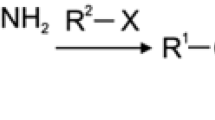Abstract
Intravascular injection of angiographic contrast media results in peripheral vasodilation and hypotension. The mechanisms underlying these hemodynamic changes are not entirely clear. We hypothesized that increased formation of nitric oxide (NO) could be involved in the vasodilatory response to contrast media. To address this assumption we have investigated whether NG-monomethyl-L-arginine (L-NMMA, 200 mg/kg) and NG-nitro-L-arginine methyl ester (L-NAME, 50 mg/kg), two specific NO formation inhibitors, can abolish the hypotensive response to intravascular injection of isopaque amin (1 g/kg), a contrast medium, as well as bradykinin (10 µg/kg), a NO-dependent vasodilator, in anaesthetized normotensive rats. In rats before pretreatment with L-NMMA and L-NAME, the absolute values of the average fall in mean arterial pressure (MAP) induced by intravascular injection of isopaque amin and bradykinin were 21.3 ± 2.1 and 37.2 ± 4.4 mmHg, respectively. Pretreatment with L-NMMA and L-NAME failed to affect the hypotensive response to isopaque amin; by administering isopaque amin in rats pretreated with L-NMMA and L-NAME the absolute values of the average fall in MAP were 25.6±4.9 and 23.4±3.9 mmHg, respectively, similar to the average fall in MAP before treatment with NO formation inhibitors. In contrast, the hypotensive response to bradykinin was significantly inhibited; by administering bradykinin in rats pretreated by L-NMMA and L-NAME, the absolute values of the average fall in MAP were 10.2±2.8 and 7.2±2.2 mmHg, respectively, much less than the average fall in MAP before treatment with NO formation inhibitors. We conclude that intravascular injection of isopaque amin causes reduction in systemic arterial pressure. However, this vasodilative effect seems unrelated majorly to augmented endothelium-derived NO formation.
Similar content being viewed by others
References
Steiner R, Grainger R, Memon N, Weiss D, Kanofsky PB, Menduke H (1980) The effect of contrast media of low osmolality on the peripheral arterial blood flow in the dog. Clin Radiol 31:621–627.
Hilal SK (1966) Hemodynamic changes associated with the intra-arterial injection of contrast media. Radiology 86:615–633.
Fischer HW (1968) Hemodynamic reactions to angiographic media. Radiology 91:66–73.
Lindgren P, Törnell G (1958) Blood circulation during and after peripheral arteriography: Experimental study of the effect of triurol (sodium acetrizoate) and hypaque (sodium diatrizoate). Acta Radiol 49:425–440.
Palmer RML, Ashton DS, Moncada S (1988) Vascular endothelial cells synthesize nitric oxide from L-arginine. Nature 333:664–666.
Ress DD, Palmer RMJ, Moncada S (1989) Role of endothelium-derived nitric oxide in the regulation of blood pressure. Proc Natl Acad Sci USA 86:3375–3378.
Ress DD, Palmer RML, Moncada S (1990) Characterization of three inhibitors of endothelial nitric oxide synthase in vitro and in vivo. Br J Pharmacol 101:746–752.
Murad F (1986) Cyclic guanosine monophosphate as a mediator of vasodilation. J Clin Invest 78:1–5.
Ignarro LJ (1990) Nitric oxide is a novel signal transduction mechanism for transcellular communication. Hypertension 16:477–483.
Lincoln TM, Cornwell TL (1991) Towards an understanding of the mechanism of action of cyclic AMP and cyclic GMP in smooth muscle relaxation. Blood Vessel 28:129–137.
Nishimura J, Van Breemaen C (1989) Direct regulation of smooth muscle contractile elements by second messengers. Biochem Biophys Res Commun 163:929–935.
Vallance P, Collier J, Moncada S (1989) Effects of endothelium-derived nitric oxide on peripheral arteriolar tone in man. Lancet 334:997–1000.
Pascial IF, Umans JG (1986) Effect of pregnancy on mechanisms of relaxation in human omental microvessels. Hypertension (Dallas) 28:183–187.
Wallerstedt SM, Umans JG (1997) Endothelium-dependent relaxation by substance P in human isolated omental arteries and veins: relative contribution of prostanoids, nitric oxide and hyperpolarization. Br J Pharmacol 120:25–30.
Uramkami-Harasawa L, Shimokawa H, Nakashima M, Egashira K, Takeshita A (1997) Importance of endothelium-derived hyperpolarizing factor in human arteries. J Clin Invest 100:2793–2799.
Najibi S, Cowan CL, Palacino JJ, Cohen RA (1994) Enhanced role of potassium channels in relaxation to acetylcholine in hypercholesterolemic rabbit carotid artery. Am J Physiol 266:H2061-H2067.
Zygmunt PM (1996) Role of potassium channels in endothelium-dependent relaxation resistant to nitrarginine in the rat hepatic artery. Br J Pharmacol 117:1600–1606.
Murphy ME, Brayden JE (1995) Apamin-sensitive K+ channels mediate an endothelium-dependent hyperpolarization in rabbit mesenteric arteries. J Physiol 489:723–734.
Corriu C, Feletou M, Canet E, Vanhoutte PM (1996) Inhibitors of the cytochrome P450-monooxygenase and endothelium-dependent hyperpolarization in the guinea-pig carotid artery. Br J Pharmacol 117:607–610.
Hiroshi I, Lih K (1977) Endothelial ATP-sensitive potassium channels mediate coronary microvascular dilation to hypersomolarity. Am J Physiol 273:H104-H112.
Beny JL, Pacicca C (1994) Bidirectional electrical communication between smooth muscle and endothelial cells in the pig coronary artery. Am J Physiol 266:1465–1472.
Little TL, **a J, Duling BR (1995) Dye tracers define differential endothelial and smooth muscle coupling patterns within the arteriolar wall. Cir Res 76:498–504.
Author information
Authors and Affiliations
About this article
Cite this article
Jun, T., Danna, P., Piccaluga, E. et al. Lack of NO formation is involved in the vasodilative response to contrast media. International Journal of Angiology 9, 42–45 (2000). https://doi.org/10.1007/BF01616330
Issue Date:
DOI: https://doi.org/10.1007/BF01616330




